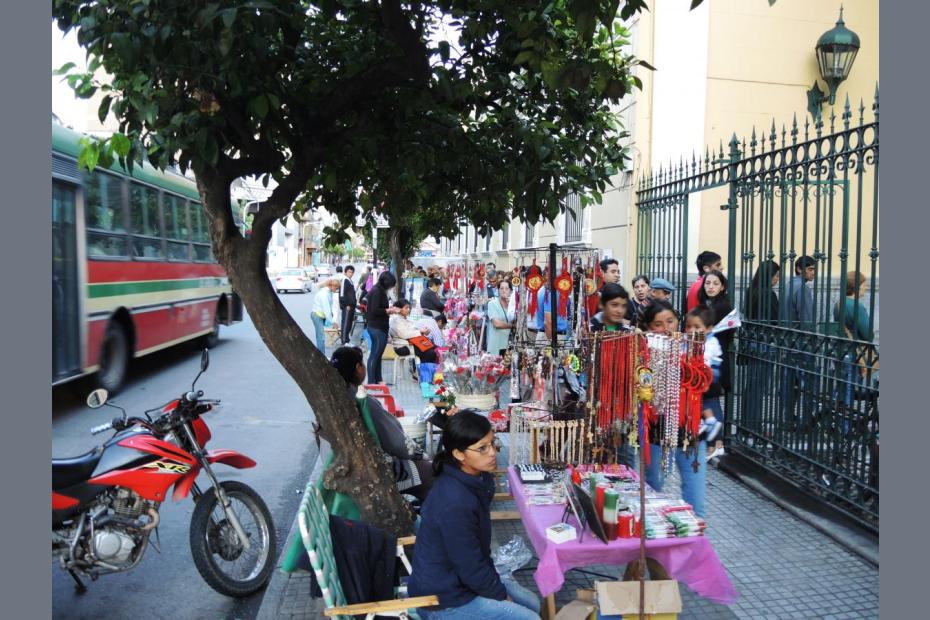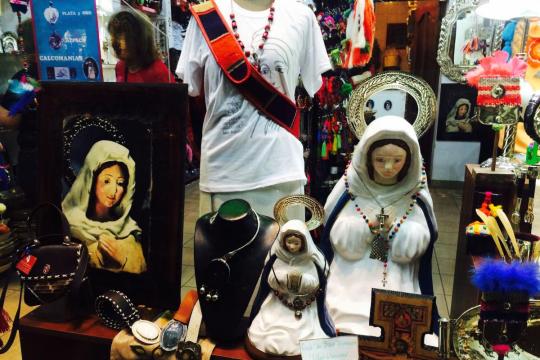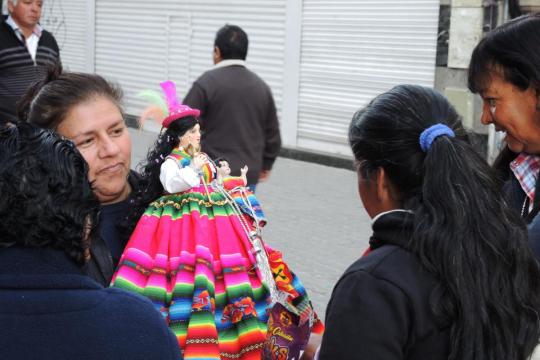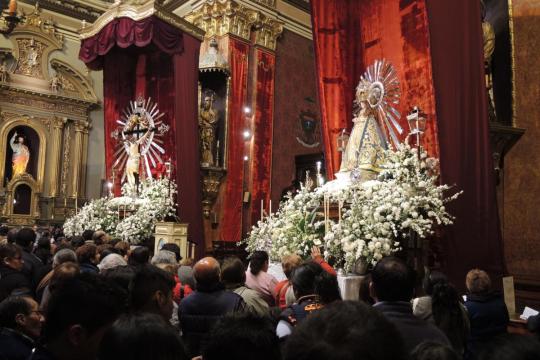Despite occasional conflicts between church and state, Catholicism has long enjoyed a very privileged position in Argentinian culture, where the overwhelming majority of people are Catholic, at least by virtue of baptism.
Occupying the largest part of the Southern Cone of South America, and stretching from Northern deserts and tropical areas to sub-polar Tierra del Fuego, Argentina shares a good deal in common culturally and religiously with other Latin American societies, particularly when it comes to the prominence of Marian devotion. Still, the Southern cone countries — especially Uruguay and Chile, but also Argentina — differ from from most other Latin societies in terms of economic prosperity and lower levels of religious practice and commitment.
By many Argentinians’ own description, Argentina is a mestizo country, a mix of Spanish, Native, African, Italian and Middle Eastern peoples and cultural influences. In the late 19th and early 20th centuries, Argentina was a major destination for emigrants from Europe, and that migration has made many parts of the country seem particularly Europeanized. While most surviving Native peoples were assimilated over generations to create that mestizo country, there are several dozen recognized Native tribes in the country.
Like most large countries, there are regional differences in practice and degree of religiosity. Buenos Aires, the capital, is commonly said to be the most pluralistic and secularized region of the country. In the desert provinces of Salta, Jujuy and Tucumán, places often seen as the traditional heart of the country, religious devotion is said to be stronger, even as one writer has claimed that the area is “perhaps closer to Bolivia in its religiosity.”1 These three provinces comprise the southernmost part of the Incan empire, and the Amerindian heritage is obvious in the faces of the people and often in the culture of the people. The areas also have been shaped by Spanish conquest and by Italian and Middle Eastern settlers who came in the late 19th and early 20th centuries.
Church and country still live to a significant degree in the shadow of the “Dirty War” period, of the 1970s and early 1980s, when Catholics were part of both leftist forces that sought social change, and the government forces that committed major human rights abuses. Many Catholics feel that the legacy of the period has not been examined critically enough, but in practical terms a stalemate has settled in most of the time. Today, lay Catholics have moved toward the center, away from political extremes, but also away from focusing on helping the poor, toward focusing on their families. Lay groups, people say, are organized around small groups of families and the parish, but not in larger ways for collective social action, as they once were through groups like Catholic Action. In more recent times, there have been strong disagreements between church and state over a new set of issues — abortion, contraception and same-sex marriage. Popular support for same-sex marriage made the country the first in Latin America to legalize it, in 2010.
The public paradox in the Southern Cone
In a number of very public, visible ways, Argentina appears to be an especially devout country. Catholic images are prominent in public spaces — on esplanades, at public schools and universities, town offices, police stations, public parks, etc. Marian feasts regularly draw out large crowds, and supplant everything else in town, sometimes for days, as at the feast of the Señor y Virgen del Milagro. This presence in public space is largely taken for granted.
But in Argentina, like its neighbor Chile, the ubiquity of Catholic images and practices in public is one half of a particular regional paradox: While Catholic symbols are often on display along streets and in government and business settings, making the countries look very deeply Catholic, a good deal of survey data reveals lower levels of religious practice and commitment than one might expect given what’s visible in public.2
In a 2014 Pew Research Center study, Argentina’s Catholics almost always ranked third from the bottom (only above those in neighboring Chile and Uruguay) on measures of religious devotion compared to Catholics from 18 other Latin American countries. Only 15 percent of Argentine Catholics claimed to attend religious services at least once a week.3 While 43 percent of Catholics say that religion is “very important” in their lives, the median for Catholics in non-Southern cone Latin American countries was 76 percent.4 Thirty-eight percent of Catholics say that they pray at least once a day, compared to a 74-percent Latin American median.5 Only 6 percent of Catholics say that they are likely to share their faith with others at least once a week,6 9 percent say they read scripture at least weekly,7 25 percent of Catholics say that theirs is “the one true faith that can lead to eternal life,”8 30 percent say they “fast for certain periods during holy times like lent,”9 54 percent believe that “the Bible is the word of God and should be taken literally,”10 and 57 percent believe in Hell.11 Though 81 percent say that they believe that “in the Mass, the bread and wine become the body and blood of Christ,” even that puts them on the lower end of the spectrum compared to other Latin Americans.12 The study finds 73 percent of Argentinian Catholics believe in evolution, and 32 percent of Catholics see “a conflict between science and religion,”13 but 90 percent say that they believe in miracles.14 A 2024 study by Pew reported that 86% of Argentinians thought that the Church should allow Catholics to use birth control, 71% that the Church should allow women to become priests, 77% that it should allow Catholics to take communion even if they are unmarried and living with a romantic partner, 64% that they should allow priests to get married, and 70% that they should recognize the marriages of gay and lesbian couples.15
In common parlance, many readers might conclude that Argentina is a relatively “secularized” or “secularizing” society. While that term is often used too loosely to be helpful, it is sometimes used to signal that religion is being removed from the public sphere of life, and relegated into a specialized “private” or “personal” sphere.16 Whatever the truth or limitations of that description to describe the North Atlantic world, something quite different seems to be at play in Argentina, where public religion abounds, but personal practice is lower, even if it is true that Catholic life remains vibrant by European standards.
Several Catholics from Tucumán province who were interviewed for this project stressed that class differences were especially salient when it came to Mass attendance, noting that middle and upper middle class Catholics felt much more welcome at Mass, and that parish life was geared to their needs, while lower class Catholics felt that they were looked down upon.
Another interviewee suggested, though, that a great deal about Argentine Catholicism could be summarized in an old but still popular saying from the colonial period, “Se acata pero no se cumple” — roughly translated as, “we accept your authority to say this, but we don’t need to comply.” Survey data suggest that at the very least, the number of people who even say that they accept that authority is lessening, though Argentina has not seen remotely the same shift to Evangelical and Pentecostal churches as in many other Latin American countries. According to a 2014 Pew Research study, 86 percent of Argentinians said that they were raised Catholic, whereas 71 percent say they are Catholic today. Some of the authority has shifted to other religions: 8 percent said they were baptized Catholic but have become Protestant, but 6 percent of the baptized now describe themselves as unaffiliated.17 Pew estimates that 91 percent were Catholics as recently as 1970.18
At present, the articles on Argentina found here focus primarily on the northwest of the country, in Salta, Jujuy and Tucumán.
In the Journal of Global Catholicism
Gustavo Morello, SJ, "Catholicism in Context: Religious Practice in Latin America," Journal of Global Catholicism 6, no. 1 (Fall 2021): 46-63, DOI: 10.32436/2475-6423.1104.
- 1Edward Cleary, The Rise of Charismatic Catholicism in Latin America (Gainesville: University Press of Florida, 2011), 176.
- 2Uruguay, the smallest country in the Southern Cone, is an even more secularized country, and differs in a number of ways in its public religiosity.
- 3“Religion in Latin America: widespread change in a historically Catholic region,” Pew Research Center, Washington, D.C. (Nov. 13, 2014), 43. http://www.pewforum.org/files/2014/11/Religion-in-Latin-America-11-12-PM-full-PDF.pdf, accessed January 15, 2016.
- 4“Religion in Latin America: widespread change in a historically Catholic region,” 41. The gender differences here are significant: 50 percent of women and 36 percent of Catholic men agreed that religion is very important (42).
- 5“Religion in Latin America,” 44.
- 6“Religion in Latin America,” 6.
- 7“Religion in Latin America,” 48.
- 8“Religion in Latin America,” 61.
- 9“Religion in Latin America,” 50.
- 10“Religion in Latin America,” 54.
- 11“Religion in Latin America,” 56.
- 12“Religion in Latin America,” 53.
- 13 “Religion in Latin America,” 99-100.
- 14“Religion in Latin America,” 255.
- 15Jonathan Evans and Kelsey Jo Starr, "Many Catholics in the U.S. and Latin America Want the Church to Allow Birth Control and to Let Women Become Priests" Pew Research Center, Sept. 26, 2024.
- 16 Cf. Jose Casanova’s summary of Thomas Luckman’s “The Invisible Religion” in Public Religions in the Modern World (Chicago: University of Chicago, 1994), 19.
- 17“Religion in Latin America,” 12, 32. The 71 percent figure is lower than the 2010 figures from Pew listed in the chart on this site, though the difference is not significant within the range of statistical probability for both series.
- 18“Religion in Latin America,” 27.
























